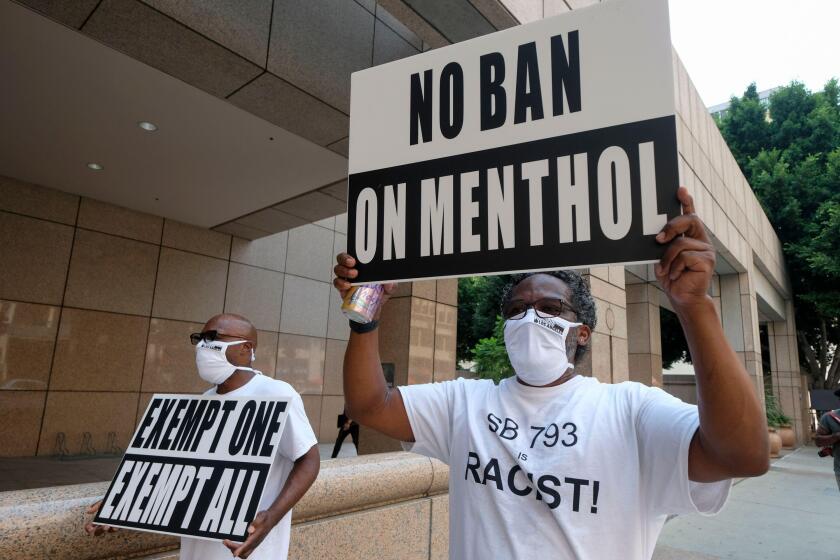Editorial: Drastically reducing nicotine levels will save a lot of lives

- Share via
Nicotine kills. Oh, not directly, for the most part. It’s just so addictive that cigarette smokers find it nearly impossible to quit a product that subtracts years off their lives, causes cancer, chronic obstructive pulmonary disease, strokes and heart disease, along with worsening Type 2 diabetes. In 2018, more than half of the smokers in this country tried to stop; only 8% did.
The United States banned enticing candy flavors and raised the smoking age in an effort to keep kids from getting hooked on cigarettes, with some success. But there are still many teens and adults who are hooked and unable to rid themselves of a habit they probably started when they were too young to know better.
The U.S. Food and Drug Administration has wanted to reduce nicotine levels in cigarettes since the 1990s. But now it has an administration willing to back the idea: President Biden is proposing to slash nicotine levels of cigarettes to minimal or “nonaddictive” levels.
The tobacco industry long played with the nicotine levels in cigarettes to make them more addictive, regardless of the suffering and premature death they caused. So it only makes sense for the FDA, charged with regulating nicotine levels under the Tobacco Control Act of 2009, to take things in the opposite direction.
The FDA plans to ban menthol in cigarettes and cigars, and the L.A. City Council took the ban an important step further. Time to rid the country of this flavoring that lures young smokers.
The nicotine plan is expected to take years to happen. And many obstacles could stand in the way: changes in administration, intense lobbying by the industry, interference by Congress and court challenges.
But for the sake of millions of Americans addicted to cigarettes, we hope that the FDA prevails. Reducing the nicotine that creates the physiological addiction to smoking would likely be far more effective than banning candy flavors or menthol (which the FDA is also considering), raising cigarette taxes or any of the other steps taken so far. People who want to quit would have a fighting chance.
The tobacco industry is opposed to the plan, of course, and claims that if nicotine levels are lowered, smokers will inhale more deeply or smoke more cigarettes to get their nicotine fix. Research has proved this wrong. A study published in May showed that cravings for cigarettes are lower when the nicotine content in them is drastically reduced. And curtailing the nicotine sharply is far more effective than doing it gradually for people trying to quit, various studies have shown.
The industry advocates instead for “harm reduction” — which essentially means getting people hooked on electronic-cigarettes instead of the combustible version. It’s not difficult to guess that its real objection to nicotine reduction is losing revenue from the millions of Americans currently hooked on the No. 1 cause of premature death.
A joint investigation has learned that Newport cigarette maker Reynolds American has hired Black lobbyists and influenced grass-roots groups to help fan fears among Black communities about menthol bans.
Smokers who want more nicotine can use patches, gum and other products to get their fix. And for now, at least, they can turn to e-cigarettes.
That’s why the FDA’s parallel decision to ban the popular cartridge e-cigarettes sold under the brand name Juul appears hasty. So far, e-cigarettes appear to be less dangerous than smoking. And though there’s legitimate concern about young people who start vaping moving on to cigarettes, that becomes less of an issue if cigarettes become nonaddictive.
The FDA acknowledges that it has no evidence of Juul products posing an imminent hazard. It says it is banning Juul because of what it calls “insufficient and conflicting data” about certain chemicals in the pods. Juul won a temporary reprieve in court while it appeals, saying that it has provided mounds of evidence to the federal agency.
No one would suggest vaping is a healthy habit; the chemicals in e-cigarettes carry potential health risks, but those risks appear to be lower than from smoking, according to the Centers for Disease Control and Prevention. For now, vaping may be a less dangerous route for smokers trying to get a nicotine fix.
What’s most important is to reduce the harm from combustible smoking products, and the FDA should include cigars and pipe tobacco in its rule lowering nicotine levels. There is no reasonable excuse to allow Americans to stay hooked on a deadly product.
More to Read
A cure for the common opinion
Get thought-provoking perspectives with our weekly newsletter.
You may occasionally receive promotional content from the Los Angeles Times.












